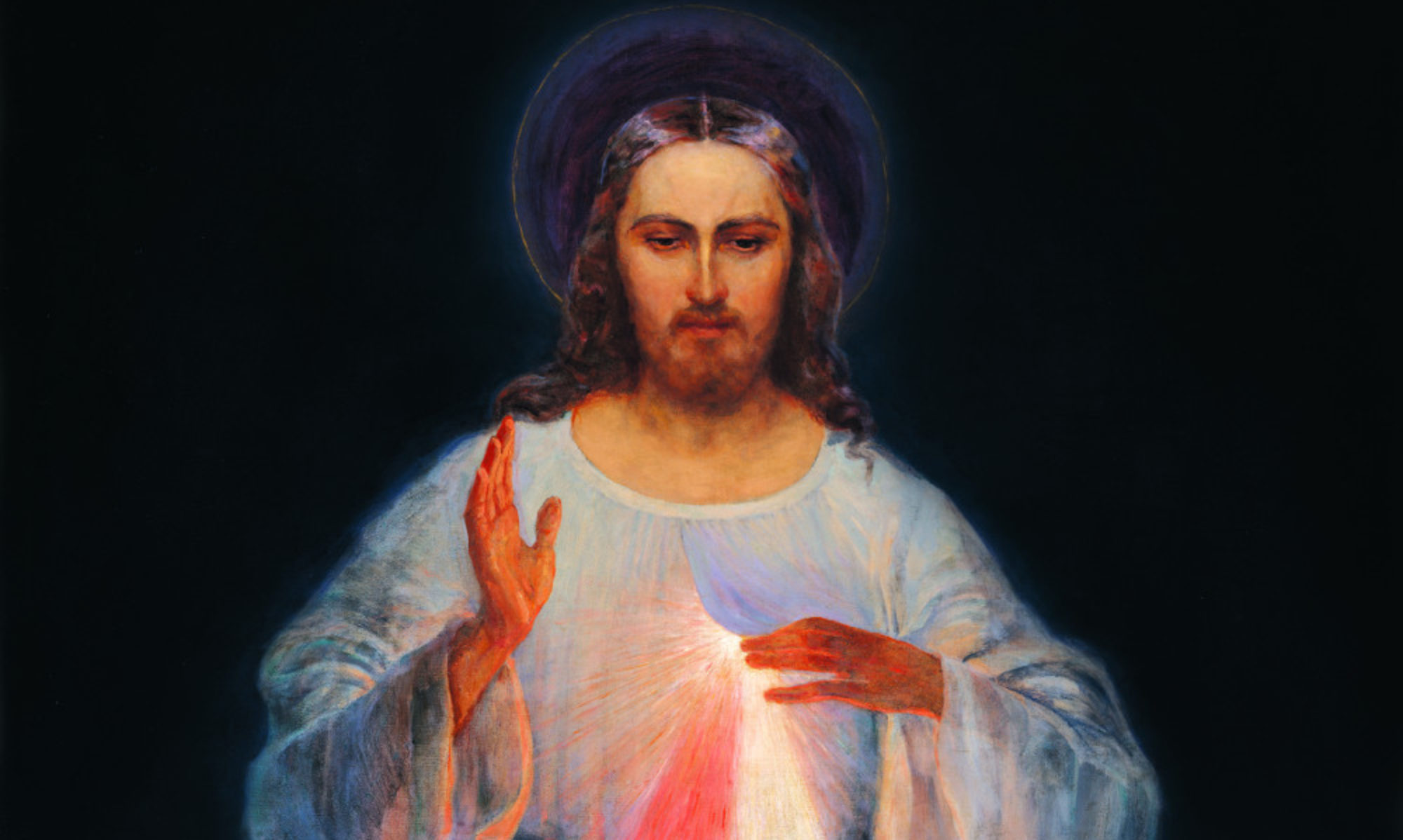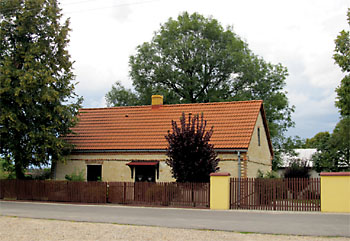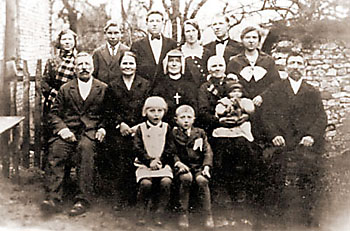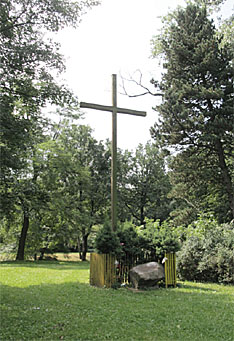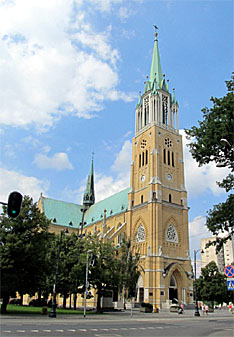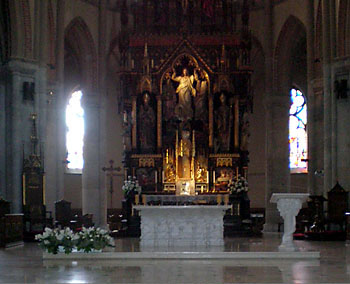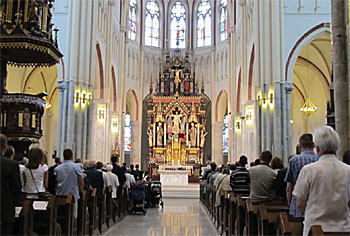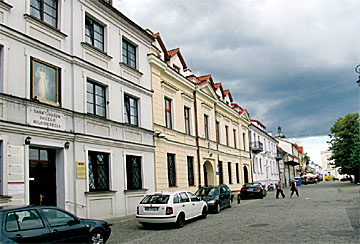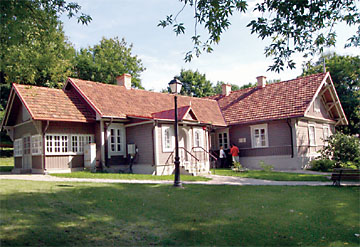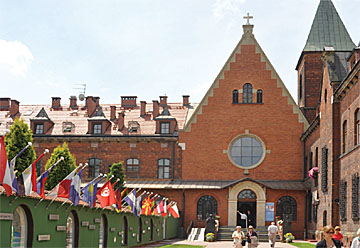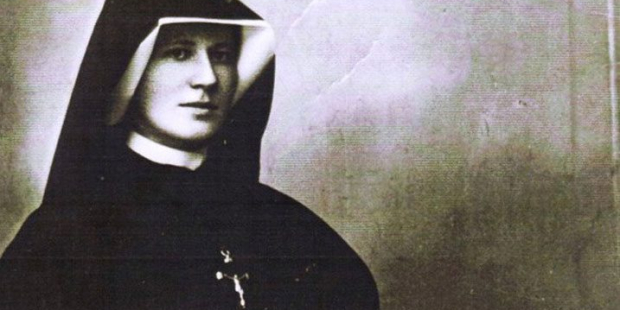
“You are the secretary of My Mercy. I have chosen you for that office in this life and the next life. That is how I want it to be in spite of all the opposition they will give you. Know that My choice will not change”
Jesus. Diary, 1605.
Saint Sister Faustina Kowalska, the world-renowned apostle of Divine Mercy and one of the greatest mystics of the Church, was born on August 25, 1905 in Głogowiec (Łódź region). She was the third of ten children, in a poor Catholic peasant family. At her baptism, in the nearby parish church of Świnice Warckie, she was given the name Helena. During her childhood she distinguished herself by acts of devotion, her love for prayer, hard work, obedience and a tremendous sensitivity to human misery.

Głogowiec – the birth place of Sister Faustina. 
Sister Faustina with her family (1935).
Despite completing only three years of schooling, in her Diary she clearly described what she wanted to achieve, in a simple, precise manner, without any ambiguity.
In the Diary she wrote about her experiences from her childhood:
“From the age of seven, I experienced the definite call of God, the grace of a vocation to the religious life. It was in the seventh year of my life that, for the first time, I heard God’s voice in my soul; that is, an invitation to a more perfect life. But I was not always obedient to the call to grace. I came across no one who would have explained these things to me.”
At the age of sixteen she left her family home for the nearby city of Aleksandrów and then moved to Łódź, where she worked as a servant to support herself and to help her parents. During this period the desire to join a convent was gradually growing inside her. Since her parents were against it, young Helena tried to deaden God’s call.
Years later, she reminiscenced about this in her Diary:
“Once I was at a dance with one of my sisters and while everybody was having a good time, my soul was experiencing internal torments. As I began to dance, I suddenly saw Jesus at my side, Jesus racked with pain, stripped of his clothing, covered with wounds, who spoke these words to me, “How long shall I suffer and how long will you keep deceiving Me?” At that moment the charming music stopped and any company vanished from my sight; there remained Jesus and I. I took a seat by my dear sister, pretending to have a headache to hide what had taken place in my soul. After a while, I slipped out unnoticed, leaving my sister and all my companions behind, and made my way to the Cathedral of Saint Stanislaus Kostka (Łódź). It was almost twilight; there were only a few people in the cathedral. Paying no attention to what was happening around me, I fell prostrate before the Blessed Sacrament and begged the Lord to be good enough to allow me to understand what I should do next. Then I heard these words, “Go at once to Warsaw (Poland), you will enter a convent there”. I rose from prayer, came home and took care of things that needed to be settled. As best I could, I confided to my sister what took place within my soul. I told her to say goodbye to our parents and thus, in one dress, with no other belongings, I arrived in Warsaw”
Diary, 9-10.
In Warsaw, she knocked on numerous convents’ doors, but with no luck. Finally, on August 1, 1925, she applied to the Congregation of the Sisters of Our Lady of Mercy, located at Żytnia Street in Warsaw, and she was accepted. Before that though, to satisfy the conditions and put together her outfit, she worked as a housekeeper near Warsaw for a family with several children.
In her Diary she described her feelings when joining the convent:
“It seemed to me that I had stepped into the life of Paradise. A single prayer was bursting forth from my heart, one of thanksgiving”
Diary, 17.

Wenecki Park in Łódź – the dance site. 
St. Stanislaus Kostka Cathedral Church in Łódź.
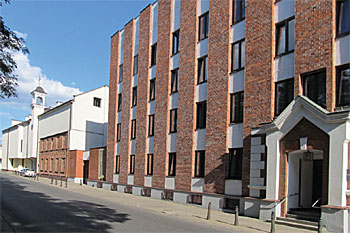
Upon joining the Congregation, Helena took on the name Sister Mary Faustina. She completed her probation in Cracow where, in the presence of Bishop Stanislaus Rospond, she took her initial religious vows, and five years later, perpetual vows professing chastity, poverty and obedience. She was assigned to work in various houses of the Congregation, spending the longest periods of time in Cracow, Płock and Vilnius, working as a cook, gardener and doorkeeper. Her extraordinarily rich mystical life was not visible to others in the convents or outside. She passionately fulfilled her duties and faithfully observed all the monastic rules. She was focused and silent, but at the same time, natural and cheerful full of a kind and unselfish love for her neighbours. Her rigorous lifestyle and exhausting fasting, which she was undertaking even before joining the Congregation, weakened her body to such an extent that already during her postulantship it became necessary to send her for medical treatment.
After her first year in novitiate, she went through an unusually painful mystic experience: her so-called “dark night”, and then, further spiritual and moral sufferings related to fulfilling the mission she was given by Lord Jesus. Sister Faustina sacrificed her life for sinners to save their souls; for that she underwent a diverse range of sufferings.
During the final years of her life, her health deteriorated significantly: she developed tuberculosis which attacked her lungs and gastrointestinal tract. As a result, she underwent two periods of hospital treatment, each lasting a few months.
Physically totally ravaged, but spiritually entirely mature being mystically united with God, she died in Cracow-Łagiewniki on October 5, 1938 in the odour of sanctity, having lived for only 33 years, including 13 years of monastic life.

The house of the Congregation of the Sisters of Our Lady of Mercy in Płock, Stary Rynek 14/18, where Lord Jesus ordered Sister Faustina to paint the image of Him as seen in her vision, and expressed a desire to establish a Feast of Mercy. 
The house of the Congregation of the Sisters of Our Lady of Mercy, Vilnius, 29 Grybo Street, where Sister Faustina was staying during the period 1933-1936 and where Lord Jesus dictated to Sister Faustina the Chaplet of Divine Mercy. 
The house of the Congregation of the Sisters of Our Lady of Mercy in Cracow – Łagiewniki (Poland), 3 Siostry Faustyny Street. The place of eternal rest of Saint Sister Faustina’s earthly remains. In Cracow, Lord Jesus expressed His wish for us to celebrate the hour of His death – the Hour of Mercy.
My Memories of the late Sister Faustina
“I met Sister Faustina in the summer (July or August 1933) when she was a penitent in the Congregation of the Sisters of Our Lady of Mercy in Vilnius, Lithuania (25 Senatorska St.) where, back then, I was an ordinary confessor. She caught my attention because of her unusual subtlety of conscience and a close union with God.
(…) On getting to know Sister Faustina better, I discerned that the gifts of the Holy Spirit worked within her in hiding, but quite often they appeared openly, granting partially the intuition that was overwhelming her soul in a lively manner, arousing surges of love and solemn heroic acts of sacrifice and self-denial. What appeared particularly often was the influence of the gifts of understanding, knowledge and wisdom that allowed Sister Faustina to see clearly the banality of earthly matters and importance of suffering and humiliations. In a simple way, she learnt the attributes of God and, most of all, His infinite Mercy.
On another occasion, she was gazing at the unreachable, beatific light; for some time she kept her gaze fixed at that extremely saving light, out of which emerged a figure of walking Christ, blessing the world with His right hand, and with His left hand lifting His robe around His Heart. Two rays gushed out of the open robe – one red and one white. Sister Faustina kept having such visions, and other sensual and mental visions, for several years. She also heard supernatural words, captured by her sense of hearing, her imagination and her mind.For fear of Sister Faustina having illusions, hallucinations or being deluded, I turned to Mother Superior, Mother Irena, to inform me who Sister Faustina was and what reputation she enjoyed among the Sisters and Superiors in the Congregation. I also requested her mental and physical health to be examined. Having received favourable opinions about her in every aspect, for some time I still took an expectant position. To some extend I did not believe. I was deliberating, praying and examining, as well as asking some wise priests for advice on what to do, without revealing what and who it concerned. This concerned the fulfilment of the alleged, firm demands of the Lord Jesus to paint that picture Sister Faustina kept seeing and to establish the Feast of Divine Mercy on the first Sunday following Easter.
Led more by curiosity of what the picture would look like rather than belief in the authenticity of Sister Faustina’s visions, I decided to arrange the painting of the picture. I contacted an artist, Eugeniusz Kazimirowski, who lived in the same house where I lived. He undertook the task of painting the picture for a certain amount of money.
(…) The work lasted a few months and finally, in June or July 1934, the picture was completed. Sister Faustina complained that the picture was not as beautiful as she saw it, but the Lord Jesus comforted her and said it was enough as it was and He added: “I am giving people a vessel with which they are to come to Me for graces. That vessel is this image with the inscription: Jesus, I trust in You.”(…) The effects of Sister Faustina’s visions, in her soul as well as in the souls of others, went beyond all expectations. If at the beginning Sister Faustina was rather frightened and worried about her ability to carry out orders and shirked them, later on she slowly calmed down and reached a state of complete security and certainty and a profound inner joy: she became more and more humble and obedient, more and more united with God and patient, absolutely complying with His Will in everything.
(…) She foretold in detail difficulties and even persecutions that I was to encounter because of spreading the cult of Divine Mercy and trying to establish the Feast of this name on Low Sunday. It was easier to bear that knowing that from the beginning it was the Will of God. On September 26, she foretold me also her own death, that she would die in ten days, and she did die on October 5. Due to the lack of time I was unable to attend her funeral.
Father Michael Sopoćko – spiritual director of Sister Faustina. Białystok, January 27, 1948.
Source: http://www.faustina-message.com/saint-faustina-biography.htm
All rights reserved: © Text compilation – Urszula Grzegorczyk
Consultation – Sister Maria Kalinowska, The Congregation of the Sisters of Merciful Jesus.
© Translation: Ewa Olszowa, Copyediting: Matthew Vinall
